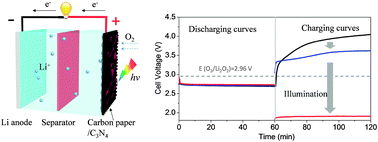Reducing the charging voltage of a Li–O2 battery to 1.9 V by incorporating a photocatalyst†
Abstract
We here present a photoassisted rechargeable Li–O2 battery by integrating a g-C3N4 photocatalyst to address the overpotential issue of conventional non-aqueous Li–O2 batteries. The high charging overpotential of a Li–O2 battery is compensated by the photovoltage, and finally an ultralow charging voltage of 1.9 V is achieved, which is much lower than that of any other conventional non-aqueous Li–O2 batteries. It is also worth noting that the charging voltage is even much lower than the discharging voltage (∼2.7 V), resulting in 142% energy efficiency (output electric energy/input electric energy, not including solar energy).


 Please wait while we load your content...
Please wait while we load your content...